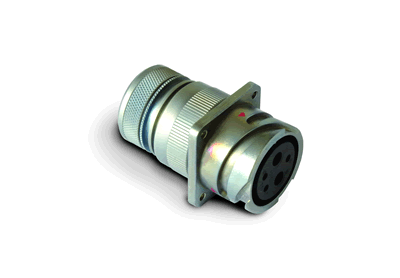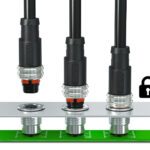Connector Platings for Modern Applications
Connector platings made from environmentally friendly materials are protecting today’s applications.
By Achim Raad, Senior Product Manager, ITT Cannon
Throughout many industries and environments, interconnect components play an integral role in ensuring the safe, reliable flow of data, signal, and power. While aluminum is currently the market standard material used to manufacture metal shell connectors because of its low cost and processability, its unique composition and characteristics make it prone to environmental stress factors.
To achieve mechanical robustness, corrosion resistance, and the level of performance required in many industrial applications, protective connector platings are often applied. Since these requirements are highly dependent on the operating environment, this article will help define and categorize the wide range of plating materials to identify the best plating treatments for the most common modern applications.
Key Features of Platings
Overall, across any industrial application, the most important plating attributes generally fall into one of these major categories: degree of conductivity, salt spray resistance (durability), shielding performance, toxicity compliance, and finish or color. Depending on the specific application, some of these features are more relevant than others.
Conductivity measures the degree to which the plating conducts electricity, and in the context of interconnect platings, is measured in shell-to-shell electrical resistance. The lesser the milliohm (mΩ) value, which is the unit of electrical resistance, the better the material allows the flow of electric current.
Plating durability is measured in the numbers of hours it can resist continuous salt spray without impacting functionality or performance. When a new plating composition is tested, a connector is exposed to a concentrated salt atmosphere, after which the corrosion level of the base aluminum material is assessed.
The shielding effectiveness of a plated connector is measured in attenuation tests and defined in decibels. This number describes the plating’s performance in both shielding the connector from outside electromagnetic interference and preventing the connector itself from emitting radiation. Because this measurement is highly complex, the shell-to-shell conductivity level, measured in mΩ, often stands in as an indicator of the shielding performance.
Toxicity compliance is an increasingly important characteristic that should be considered when selecting a plating. Some regions heavily regulate the use of environmentally problematic metals, such as cadmium. European Union (EU) regulations RoHS (Restriction of Hazardous Substances Directive) and REACH (Registration, Evaluation, Authorization and Restriction of Chemicals) are examples of policy mandates that limit the use of such materials.
Finally, for added dimension, visual appearance, and easy distinction or camouflage in complex environments, plating finishes also come in a variety of colors, each suited to different use cases.
Environmental Sustainability Trends
Environmental sustainability is one of the most important trends driving the evolution in plating materials. Specifically, many regions are applying regulations, such as RoHS and REACH, intended to control both the composition of plating materials as well as the processes involved in applying the plating.
Since 2003, RoHS regulations restrict the use of six hazardous materials in electronic and electrical equipment throughout the EU. While the industry has, for many decades, relied on cadmium platings for their excellent electrical performance, RoHS has limited the use of cadmium and other substances due to their toxicity levels.
REACH further restricts the use of chemical substances and highly regulates their use in production and end products used in the EU. When REACH is fully implemented and enforced by the beginning of 2018, all imported chemical substances and materials that contain them will be subject to the regulation. Since general exemptions for REACH will not be granted (unlike with RoHS), many companies have been wisely investing time in understanding this complex subject in recent years. A current prominent example is hexavalent chromium, which has been used for its conductive passivation properties in some platings. Although exemptions may be granted in exceptional cases, this material has been given a “sunset date” of September 2017 that effectively bans its use in production in Europe.

ITT Cannon’s Blue Generation plating is a zinc nickel plating that has similar performance properties to cadmium but is fully RoHS and REACH compliant.
Key Features by Major Application
Every industry and interconnect application presents a distinct set of requirements, necessitating application-specific plating solutions. While some areas demand maximum performance, others require outstanding durability and reliability. The following section provides an overview of the most emphasized attributes, and the reasons behind them, across different industries.
Defense
Connector platings used in military environments must adhere to strict, region-specific military standards, the most prevalent of which are the U.S. “MIL” and European “VG” standards. Electrical connections in these environments must generally meet the highest performance criteria. While MIL and VG standards vary slightly in test procedures and specifications, both typically require at least 500 hours of salt spray resistance and shell-to-shell conductivity between 2.5 and 5 mΩ.
The most common military-certified plating in use is still cadmium, due to its excellent electrical performance and the general exemption of defense applications from RoHS regulations. However, newer black zinc nickel and zinc cobalt variants represent RoHS-compliant alternatives for some military applications, and they are increasingly used by manufacturers worldwide.
Transportation
In transportation applications, such as rail and heavy and off-road vehicles, connector platings have to provide superior durability and signal integrity.
In today’s railway industry, original equipment manufacturers are striving to extend the lifetime of rolling stock equipment. With critical connectors on the outside of the railcar, corrosion resistance is key. Some of the platings that are used in this environment are zinc nickel-based, thanks to its salt spray resistance of up to 500 hours and excellent shielding properties. For outdoor applications that don’t require shielding, epoxyurethanic varnish can deliver the same level of corrosion resistance.
In heavy and off-road vehicle applications, connectors must endure vibration, shock, dust, and extreme weather conditions, in addition to being exposed to fuel and engine fluids. The most commonly used platings in these applications are zinc nickel, which provide effective shielding and up to 500 hours of salt spray resistance; zinc cobalt, which offers 200 hours of salt spray resistance and reduced shielding performance; and highly cost-effective electroless nickel, which provides exceptional shielding performance but reduced salt spray resistance.
Industrial
Nickel platings are the industrial standard for indoor applications, and they provide excellent shielding performance with a shell-to-shell conductivity of 5 mΩ or less. In industrial automation applications within a protected indoor factory environment, these cost-effective versions are desirable. For more demanding outdoor environments, such as power generation and construction machinery, the industrial world employs plating solutions such as zinc nickel and zinc cobalt, which are much better suited to environmental extremes.
Environmentally Friendly Platings Are the Future
While connector platings differ across industries, applications, and regions, using a complex combination of chemicals that provide application-specific properties is critical to the overall reliability and durability of any given interconnect solution. A growing trend across all markets is the move toward environmentally friendly materials, driven by international regulations such as REACH and RoHS. Many manufacturers already offer compliant solutions that provide the same or better performance than their toxic alternatives, such as ITT Cannon’s Blue Generation plating, and they continue developing innovative platings to fully replace hazardous chemicals.
Recently posted:
[related_posts limit=”10″]






